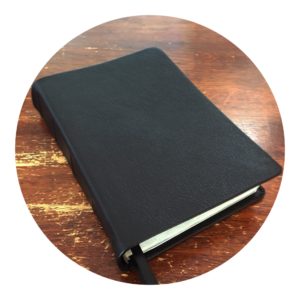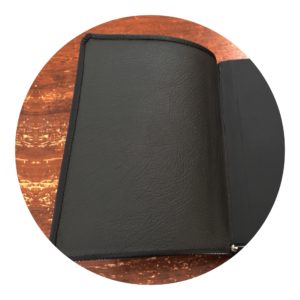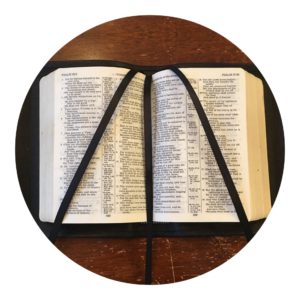Bible rebinding can be done in a variety of styles, from hard covers to full leather lined covers. Below are some of the components of your bible that will be worked with. This will give you a better idea of what your bible is composed of so that we can customize it to your preferences.
Cover
 Often Bible's need to be rebound because the cover has failed. This is because most covers are made of materials that are not intended to take daily use. Using real leather, we can exponentially extend the life of a binding. We recommend goatskin leather that is specifically tanned for bookbinding. This leather is intended to last.
Often Bible's need to be rebound because the cover has failed. This is because most covers are made of materials that are not intended to take daily use. Using real leather, we can exponentially extend the life of a binding. We recommend goatskin leather that is specifically tanned for bookbinding. This leather is intended to last.
 Liner
Liner
When rebinding with a Leather Lined style binding, not only is the outside leather, but the inside is also lined with leather and the text block is tabbed to the leather liner. This means there are two pieces of leather that make up the cover. This makes for a durable and yet supple cover.

Endbands
Classically, endbands have been used to protect the textbook where it's most likely to come in contact with the bookshelf. At the top and bottom, or head and tail of the book. Most endbands today are manufactured, however, they can be hand sewn which creates an incredibly one of a kind look.

In general, we use manufactured silk or handmade leather endbands. These still serve their purpose and are a much more economic option.
 Ribbons
Ribbons
Your average bible comes with just one bookmark, but while we have the bible apart, why not add more? We will can add multiple bookmarks during the rebinding process. Often times higher quality than the ones that came with your bible originally. These are available in just about any color you could possibly think of, they can all match, or they can each be a different color. The choice is yours. We use high quality double face satin ribbons for our bookmarks. They can come in the standard 1/4" size or a slightly larger 3/8" size.

Ribs
Historically books were sewn onto cords and when the leather was placed over those cords it was left raised. While we still bind historically correct books like that today, most sewn binding produced today do not use cords and so the ribs along the spine are merely for aesthetics. We offer a few options for ribs. The first is shown on the Right and it is called Raised Ribs. These are created by laying thick leather on the inside of the spine and tooling around that leather to define it.

A second option is shown the Left and it is called Tooled Ribs. These are tooled onto a finished cover with hand tools called pallets. Pallets are heated up on a finishing stove and then hand applied to the spine to produce the desired look. Often times the color and depth of the tooling depends on the leather used. Some leather tool darker, creating more defined lines, while other leathers won't vary as much in color once tooled.
Request a Quote
I'd love to be able to help you bring new life to your bible.